| The
Lowdown on Licensing:
ToyDirectory talks with Lucasfilm, McFarlane Toys, and Toys R Us
for a view of the whole food-chain
By Tim
Connolly
November 1, 2002
Let’s
do a word problem: If the toy industry is a 25-billion-dollar-a-year
business, with licensed product making up over a third of that figure,
how long will it take a train traveling 60mph to reach Omaha with
a boxcar full of SpongeBob SquarePants® dolls? The answer? It’s
already unloaded and gone back for more.
“Property”
licensing--the kind that offers the rights to a known character
or trademark—has far outpaced “concept” (aka patent)
licensing since the 1990’s, a trend that shows no signs of
waning. According to industry research firm NPD funworld, 2002’s
increased sales of action figures and special-feature plush was
indicative of “categories [that] reflect the increased upward
growth of licensed products, fueled by hot movies and nostalgic
properties.” Next stop: The Holidays!
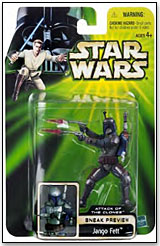 Star
Wars Action Figures
Star
Wars Action Figures |
Licensor:
LucasFilm Ltd.
In
1997, LucasFilm made industry headlines when it signed a $600-million-dollar,
nine-year contract with Hasbro--not so surprising really, when you
consider the property. Far more than a hot movie franchise, the
Star Wars saga has become so ingrained in our culture as to become
a modern myth. Given that kind of brand awareness, you’d think
the licensor’s job would be a simple matter of watching the
royalty checks roll in.
“We
never rest on our laurels,” says Licensing President Howard
Roffman. “It’s a competitive world out there…Star
Wars earns the shelf-space it gets.”
Having
been with the company for twenty years, Roffman has had the privilege
of watching his original customer base grow-up to become parents,
and pass their love of Star Wars on to their children. “You
couldn’t ask for a stronger brand endorsement,” he says.
“At the same time, we have to recognize that their children
are growing up in a different time…bombarded with messages
from other properties that are vying for their attention.”
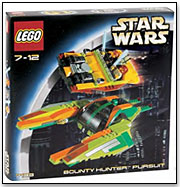 Star
Wars LEGO Toys
Star
Wars LEGO Toys |
So
how does a twenty-five-year-old franchise stand out amongst a sea
of Furbys and the aforementioned SpongeBob? “Retail differentiation
is an important part of our marketing strategy,” says Roffman.
“Each of the major retailers IS different, and they deserve
to be differentiated in a meaningful way.”
With
the release of last summer’s Attack of the Clones, the tactic
for keeping Star Wars toys front-and-center was, ironically, to
ship less product. “We’re the first to admit that in
1999 [for Phantom Menace] we oversupplied the market. But, in fairness…it
was hard to gauge the demand…there had not been a new Star
Wars film for 16 years.” In spite of having one-third fewer
licensees for Attack of the Clones, the film’s projected merchandising
total nearly equals Phantom Menace’s $2 billion worth of properties.
What
does Roffman see in the Saga's future? “We take our role as
Shepard’s of the [Star Wars] brand very seriously… We’ll
carefully look at our results, not only for this year but for 2003
and 2004, in making our decisions for Episode III in 2005.”
To read the complete interview with Howard Roffman
(click here).
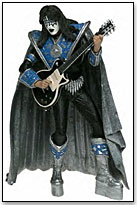 Kiss's
Ace Frehley by McFarlane Toys
Kiss's
Ace Frehley by McFarlane Toys |
Manufacturer:
McFarlane Toys
For
action figure powerhouse McFarlane Toys, the company’s own
name is their most potent brand. Known for making unique, high quality
figures, McFarlane’s lineup includes horror movie characters,
rock stars, fantasy figures, and pro sports heroes. “Across
the board, we create collector appeal,” says Christine Finch,
Executive Director of Licensing for McFarlane. “Many of the
ideas from the licenses are suggested or supported by our sincere
fan base.”
In
1997, the company began to branch out from solely producing artist
and founder Todd McFarlane’s “Spawn” figures.
Its latest line features stars of the NBA, NFL, and Major League
Baseball. “Hasbro opted out of sports, that’s when we
grabbed them,” says Finch. “It’s really taken
off.” McFarlane currently has 7 contracts for four sports
lines, producing twelve new figures a year.
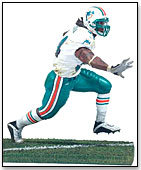 Ricky
Williams by McFarlane
Ricky
Williams by McFarlane |
The
company also signed merchandising super-group KISS in 1996, and
has enlarged their music line to include rock icons such as Jerry
Garcia, Jim Morrison, and Angus Young. On dealing with rock stars,
Finch is diplomatic: “It’s a little more difficult.
Sometimes working with an estate can be easier than working with
a live person.”
So
what’s on Christine’s wish list? “I keep hoping
someday we’ll get Star Wars,” she says musingly. “But
Hasbro…it’s a perfect fit for them.” On the licensing
industry as a whole, she describes it as “a very fine balance
of…knowing your marketplace, collaborating with your retail
partners, and most importantly…retaining the interest of your
ideal consumer.”
Retailer: Toys R Us
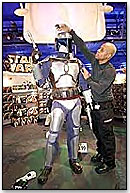 Toys-R-Us
Star Wars Shop
Toys-R-Us
Star Wars Shop |
It’s
that “ideal consumer” that every retailer is trying
to woo, and with more and more TV and movie-themed toys flooding
the market; the pressure is on for a property to prove itself—quickly.
“Kids need to have an interest in the TV show or movie,”
says James E. Feldt, President of Merchandising and Marketing for
Toys R Us.
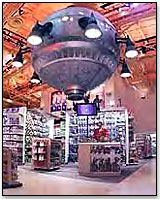 ET
Store "in-store shops"
ET
Store "in-store shops" |
He
adds that there are other considerations beyond the appeal of the
property itself: “More importantly, the size of the buy…[Toys
R Us is] much more focused on product life cycle.” As for
those“evergreen” properties that can be counted on to
have a long shelf-life, Feldt cites Spiderman, the Teletubbies,
Pooh, Power Rangers, and of course, Barney.
Creating
“in-store shops” is one way Toys R Us and many other
retailers are creating maximum brand exposure for hot properties.
By gathering the entire spectrum of Blues Clues or Jurassic Park
toys into a store-within-a-store, consumers can easily find the
toy they’re after--in a setting that’s ripe for impulse
purchases of similar products. Toys R Us has found the strategy
so successful, they plan to re-make half of their 600 stores to
include in-store shops.
Does
exclusive floor-space translate into more exclusive agreements with
licensors? “Where it makes sense in our assortment,”
says Feldt, but he adds, “We will continue to be more selective…”
Additional sources for this article:
“Studio Tours” by Bruce Apar, License! June 2002
“Retail Real Estate” by Dawn Wilensky, License! August
2002
“Licensing 101” by Carol Rehtmeyer, toysngames.com
RELATED
LINKS:
 Side
Bar: LucasFilm's
President of Licensing Howard Roffman Takes You Behind the Scenes
of a Licensing Blockbuster.
Side
Bar: LucasFilm's
President of Licensing Howard Roffman Takes You Behind the Scenes
of a Licensing Blockbuster.
Want to see more Action Figure Toys? Click
Here...
Return to ToyDirectory Monthly front page: Click
Here
Send comments about this article to: emailtoydirectory@gmail.com
|
